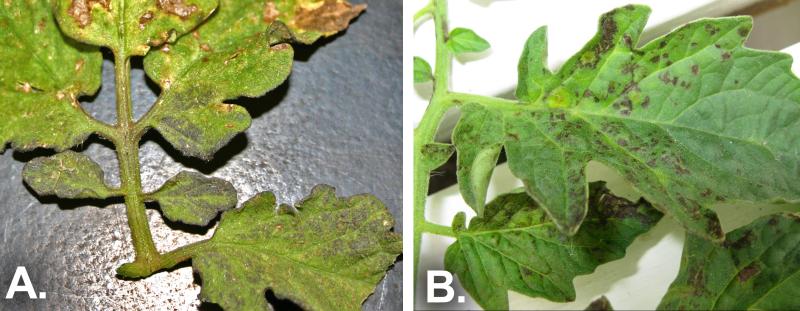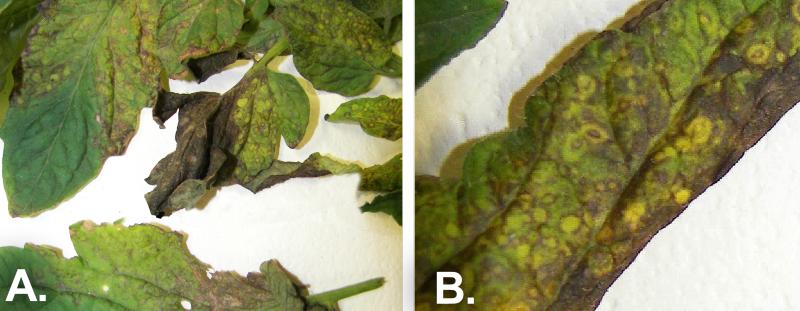Written by Rhoda Burrows, former Professor & SDSU Extension Horticulture Specialist.
It’s the time of year that seed catalogues start arriving. If you start your own plants, you will want to select varieties that have good resistance to diseases that are common in this area. One that appears sporadically, but has been almost epidemic in Western South Dakota the last year or two is Tomato Spotted Wilt Virus (TSWV).
Last spring and summer we observed numerous tomato plants that were looking sick after being transplanted. In some cases the leaves had some purplish-bronze tinge to them, or the growing points turned brown and died. In other cases, the leaves had scattered small brown spots, particularly toward their stems. The symptoms were not quite what we had seen before, but laboratory tests confirmed that the cause was Tomato Spotted Wilt Virus. This virus can be a problem in both field and greenhouse situations, and most frequently its effects in South Dakota are observed on tomatoes and peppers.
Symptoms

Leaves & Foliage
Symptoms on the leaves can be variable. On approaching the plant, one may notice that the newer foliage has a bronze or purplish tinge to it (Figure 1-A), or it may even die back. Sometimes the plants are stunted, or look wilted. Leaf symptoms may first appear as small, light brown flecks (Figure 1-B).

Closely examine a number of leaves. Sometimes a portion of a leaf (either base or tip) will look normal, while other portions dying back or exhibiting one or more green spots bordered on the outside by brown tissue (Figure 2-A, Figure 2-B). Spots with normal-looking centers are almost always a sign of a virus. In contrast, fungal and bacterial diseases start from the center and spread outward, so there is no green center with those diseases.

Fruit
The fruit is usually infected also and may exhibit raised circular areas, sometimes ringed with small brown spots (Figure 3-A). As the fruit ripens, the distinctive spots can quickly become very obvious against the red background. Again, if the spot on the ripe fruit has a red center or red and yellow target pattern, one may be quite sure the cause is a virus (Figure 3-B). If the plant is infected when it is very young, it may not set fruit at all.
Transmission
Thrips, very tiny, cigar-shaped insects which move from plant to plant are responsible for transmitting the TSWV. Thrips thrive in warm dry springs, thus during hot dry years, we tend to see more thrips and more plants infected with TSWV. Symptoms may appear on plants within a few weeks after infection. Immature thrips feed on infected tissue, and the virus multiplies in their midgut and other organs, and once the thrips become adults, they can subsequently transmit the virus to whatever they feed on for the rest of their lives. Thus, management of TSWV is dependent on reducing thrips, and on selecting TSWV resistant varieties.
Management Tips
- Suspected TSWV infections should be confirmed. As a first step, photos clearly showing infections can be submitted to SDSU Extension specialists. If symptoms are not clear, samples should be submitted for testing. The best material for testing is that which has symptoms but is still alive, and it should be shipped so that tissue remains as fresh as possible. The SDSU Plant Diagnostic Clinic can do this test and can be contacted at 605.688.5545 or by email. See the clinic’s submission guidelines for additional information.
- Whenever available, use plant varieties with resistance to TSWV as a part of any control program (Table 1). However, it’s been reported that the flowers of resistant plants may not be resistant, so the plants may still be infected if thrips are present during flowering.
- Take steps to reduce thrips populations. If insecticides are used, select ones such as those containing the active ingredient Spinosad, which is less likely to kill natural enemies such as minute pirate bugs. Light-colored or reflective mulch may reduce thrips infestations.
- Materials that induce systemic resistance in plants may help reduce infections, but need to be applied prior to feeding by the thrips. These include sprays that contain salicylic acid, harpin proteins, or other substances.
- Remove all infected plant materials. Symptoms of TSWV typically take 10-14 days to develop after the thrips transfer the virus. Remove plants that touch or surround the plants that show symptoms, as the virus may have already been spread by thrips moving from the infected plants and the symptoms have not yet had time to become obvious.
- Many weed species can act as alternate hosts for TSWV and thrips. Thus, weed control is an important part of managing TSWV, especially in and around greenhouses or high tunnels.
- Many herbaceous ornamentals are also susceptible to TSWV infection as well. If these are growing nearby tomatoes or peppers, they may become infected or even act as an initial source of the disease.
-
For additional information on TSWV, view this helpful Tomato Spotted Wilt Disease publication courtesy of U.C. Davis and U.C. Cooperative Extension.
|
Tomato Variety |
Notes |
|---|---|
| Amelia | Medium size fruit; high yield |
| Bella Rosa | Heat tolerant; productive; large fruit |
| BHN 444, 640 | High yield; very firm tomato |
| Fletcher | Good yield, firm bright-red medium-sized fruit |
| Health Kick | Small plum-shape fruit with extra lycopene |
| Mountain Glory | TSWV tolerant, large red fruit |
| Mountain Honey | Grape type; indeterminate; very sweet; intermediate res. |
| Mountain Majesty | Very good flavor; large fruit; TWSV tolerant |
| Plum Regal | Plum tomato; high yield, some resistance to early blight |
| Primo Red | Relatively early; large fruit; good-eating quality |
| Quincy | Very High yield |
| Red Defender | High yield; fruit size ranges from small to large |
| Summerpick | Large fruit; concentrated fruit set; orange-red |
| Talledega | Large fruit; heat resistant |
| Top Gun | Heat tolerant; high yield |
| Tribute | Small to medium fruit; good producer |
| Tribeca | Very good flavor; many fruit, small to medium; pale interior |
|
Bell Pepper Variety |
Notes |
| Declaration | TSWV tolerant; high yield |
| Heritage | Very high yield; large fruit |
| Magico | High yield |
| Plato | High yield; very good resistance; large dark-green to red fruit |
| Stiletto | Lower yielding |


